Editorial
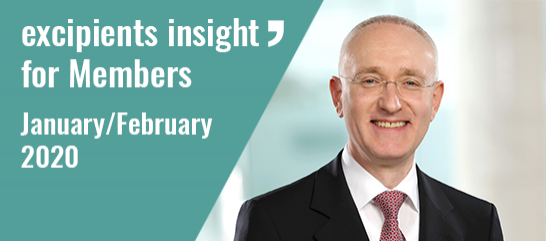
Dear Members,
As always, it was a great pleasure to see so many new and familiar faces at our recent Annual Forum in Aix-en-Provence. As I was gathering my thoughts for this editorial, I was reminded of a poem by Robert Browning with Aix in its title … while it’s not the same ‘Aix’, it talks of bearing good news and with that thought in mind, I do believe I can bring to you the good news that we have just held another very successful meeting! Thanks to our Secretariat and the Events Committee once more for delivering a great venue and programme. This issue of Excipients Insight provides some highlights of what was presented and discussed and if you weren’t able to attend, please get in touch with us at info@ipec-europe.org for more details.
While the Forum is one event, in many ways this is becoming an ‘IPEC week’: the IPEC Federation joined us once more for its annual general assembly and several committees of IPEC Europe gathered to begin this year’s programmes of work. How we can optimise the programme for the benefit of all who attend is something we’ll be considering as we plan for the next Forum - already announced to be held on 04 Feb 2021 in Bordeaux so hold the date!
I’d like to acknowledge here two new groups who held their inaugural meetings in Aix, namely the Lactose Interest Group and the Multicompendial Compliance Task Force. In many ways, this represents a new way of working for us and one which we may seek to replicate across other committees as we monitor how things go as the year progresses. At the Annual General Meeting we announced that the Pharmacopeia and Harmonisation Committee would not be regenerated. Rather, the task force approach driven by a specific topic or issue is how we’ll move forward. We hope that will help us to be more proactive and agile in developing IPEC Europe positions. We hope it will provide a better way to engage more volunteers, reaching beyond our official contacts to tap into expert resources from across the breadth of the membership. This is a very complementary initiative to those IPEC Europe stalwarts who continue to help steer the association in line with our mission and I’d like to thank those who make such a great contribution to these efforts.
And talking of future direction, we have now entered our next phase of development with the IPEC Europe Agenda 2025. In the coming months, the Board (or Administrators of the Management Body as we’re now called under the new Belgian law for asbl’s!) will be laying out our roadmap for the next five years. Exciting times ahead, no doubt! Meanwhile, I wish you all a very successful year and indeed, decade!
Until the next time,
Frithjof Holtz
IPEC Europe Chair
Highlights from the 2020 IPEC Europe Annual Excipients Forum
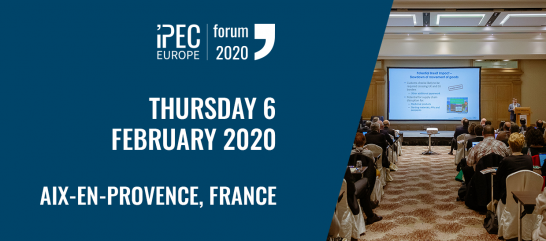
The 2020 IPEC Europe Annual Excipients Forum took place on Thursday 6 February in Aix-en-Provence, France, providing current insights into the commercial, regulatory and scientific issues affecting both suppliers and users of pharmaceutical excipients. IPEC Europe’s chair, Frithjof Holtz, welcomed participants and previewed the day’s programme.
First up was Cathie Vielle, Head of the European Pharmacopoeia Department with a presentation on EDQM’s Current and Future Regulatory Perspectives, focussing on the European Pharmacopeia. Highlights included a review of the new EDQM webpage on International Harmonisation with an update on PDG and its future interactions with ICH (to share Q4B-related texts with sister pharmacopoeias outside PDG) and the International Meeting of World Pharmacopoeias (to share all PDG texts). At the EDQM level, the programme of revision of the general monograph continues but of particular note is the draft of Substances for Pharmaceutical Use published in Pharmeuropa 32.1, January 2020. The ‘Production’ section addresses the current ‘hot topic’ requiring manufacturers to perform a risk assessment to evaluate the theoretical risk of N-nitrosamine formation and contamination and the need for a strategy to detect and control N-nitrosamine impurities in the substances. This now explicitly includes excipients in scope, and EDQM welcomes constructive feedback on these proposals before the deadline of 31 Mar 2020. Cathie stressed the value and importance of the re-launched on-line platform for Pharmeuropa, Knowledge database and Ph. Eur. 10th Edition as important sources of the latest developments for medicines and their constituents in Europe.
Next, tackling the now very real subject of Brexit: What’s the Deal?, Lynne Byers, of NSF Pharmaceutical Services covered the whole spectrum of the likely impact on medicines at the end of the transition period for the UK’s full exit from the EU. The UK has developed pragmatic plans to maintain medicines supplies, effectively continuing to recognise all pre-existing EU processes for the supply of medicines into the UK. However, the EU is resolute that henceforth the UK will be classified as a ‘third country’ and if ‘no deal’ scenario becomes a reality as of 31 Dec 2020, the ramifications of this could result in delays or interruptions to the supply of medicines. Inevitably, all activities across the product life cycle and supply chain could be impacted with everything from clinical trials, pharmacovigilance, regulatory inspections and testing on importation being affected. The plan is for multi-country packs will continue to be accepted with certain provisos. Customs checks are likely to be required crossing UK and EU borders causing supply chain disruptions of not only medicines but also starting materials, APIs and excipients. Lynne made a specific reference to excipients in that medicines manufacturers currently rely on 1000s of excipients. Whilst the general situation is that many excipients are exempt from REACH but, if they are classified as substances of very high concern then the legislation applies. The UK has set up own REACH registration process.
The level of activity in China related to drug regulation in recent years has been nothing short of staggering. It’s a common occurrence that many programmes such as the IPEC Europe Forum regularly feature the latest developments there and how companies interpret new requirements. Providing a concise overview of the evolution of drug regulations in China and their current status, Yuwei Heinzel, of Merck KGaA addressed how the current China Drug Administration Law effective 01 Dec 2019 came to be. A key message in this revision is the implementation of the Marketing Authorization Holder (MAH) as wholly responsible for the drug in its entirety including the API/Excipient/Packaging material co-review procedure. The intention is that these new reforms will encourage innovative drug development and enable the rapid entry of new medicines into the market. NMPA (National Medical Product Administration) adopted a registration procedure similar to the US DMF process with standalone registration of excipients. Mandatory dossier requirements in China are similar to APIs according to ICH guidelines, or even more exacting, which has raised significant concerns with industry and the need to share detailed, confidential information. Excipient registration places a huge burden on excipient manufacturers and suppliers and so to ensure a successful outcome, MAHs need to build strong relationship with material suppliers to ensure that adequate information is made available. As a relative new process, change management procedures are still developing but is prescribed that major quality relevant changes shall be submitted as supplements. Other changes should be updated on the registration platform in a timely manner.
The China Pharmacopoeia Commission is an important department responsible for the quality standards of product to be marketed in China. Compliance with ChP is required and the level of activity in terms of new and revised monographs is very high for the China Pharmacopoeia Commission. Harmonization with other pharmacopoeias is still in early days which results in many compliance challenges for MAHs. It is important for companies to monitor ChP changes and engage with ChPC as opportunities arise to drive alignment with other pharmacopoeias.
We continued on the China theme with Cécile Subra from Gattefossé on the experience of her company through the Bundling Review.
Like Yuwei, Cecile likened the structure of the bundling dossier to a US DMF noting that one dossier is required for only one manufacturing site; listing back up site is not an option in her experience. NMPA experts focus heavily on the manufacturing process such as raw materials. Not only are specifications required but also the identity of the suppliers. Examples of supplier CoAs are included in their dossiers. The level of proprietary and confidential information requested is very controversial with excipient manufacturers. For example, the application should give a complete description of the equipment used, equipment suppliers and even the detailed references for each piece equipment. Whatever the classification of the excipient "new" or "unknown", complete process development must be presented with process validation. A retrospective validation performed on trend analysis covering for example, 10 years of production, may be accepted if a suitable rationale is provided. Stability studies are another priority area. Since 2015, NMPA implemented ICH guideline for drugs and requested the same for excipients. Applicant must present stability in stress conditions in particular 90% of humidity, accelerated stability and long-term stability. Conversely, the chapter dedicated to toxicological endpoint does not seem to be a priority for NMPA.
Full information to demonstrate precedence of use should be presented as well as cross references to uses in cosmetics and foods, if any. Of course, conformity to Chinese, European and USP-NF monographs must be demonstrated with validated methods.
In summary, applicants need to be patient! Even for an established excipient, it could take at least 12 months to obtain a final decision. Expect that you may have to do things such as new and repeat testing which are not required in other markets which of course, can generate additional costs. A local consultant with expertise in the BR procedure and good contacts with NMPA can help to make to the process go smoother.
A panel session based on a given topic has become a popular feature at IPEC Europe events, and when consulted on what attendees would like to hear, Excipients for Parenterals often presents itself as a subject where are lots of questions to be asked. To provide a breadth of experience across the product life cycle, Andrea Hawe (Pharmaceutical Development, Coriolis Pharma), Cathie Vielle, (EDQM), Elham Blouet, Global Marketing, Roquette Frères), Julien Guedon, (Global Supplier Quality, Sanofi), Frank Milek, (Quality, Aug. Hedinger) assembled to provide some answers! To kick-off the discussion, Andrea set the scene with her presentation on Excipient Selection in Parenteral Formulation Development of Biopharmaceuticals proposing several key factors for the excipient seletion process, such as what if excipients are often not as inert as excepted and what are benefits of using excipients of higher quality and improved purity for biopharmaceutical drug products? The often-common myth that excipients are merely inert substances was dispelled in an example of a case study, illustrating that pharmaceutical grade sucrose used as an excipient contain nanoparticle impurities (NPI) can have a destabilizing effect on proteins. Use of a new sucrose quality (low in NPIs) solved the issue. Each panelist gave their perspectives on excipients destined for use in injectable drug products. The issue of biocontamination, perhaps exacerbated by today’s more complex gloabl supply chains emerged as a common concern both from the excipient supplier and customer perspectives. And again, with increasing biopharm products in the market, this is driving the need for enhanced GMP equivalent to the standards required for APIs. There was general agreement that the quality standards for the materials themselves should not attemp to include all attributes related to their intended use, but additional requirements should be agreed between supplier and the drug manufacturer. While not soley restricted to excipients for use in parenterals, ensuring traceability and having business continuity plans in place for excipient sources is growing in importance.
While there is much talk of pharmacopoeial convergence, the opposite often appears to be the case as national pharmacopeias may publish seemingly divergent requirements. Ronald Torano, GSK provided a timely reminder of what pharmacopoeias are, why they are important and the challenges of complying with multiple requirements in the global environment. Pharmacopoeias are not aligned and differences in both analytical test methods and monograph requirements could impact testing and specifications for materials and product, including excipients. Compliance with a Pharmacopoeial requirement may be waived by a regulator where it can be demonstrated that the monograph / chapter is not appropriate. In this situation, a product will be ‘otherwise authorized and approved’ by that competent authority / regulator. The best way to ensure a monograph is appropriate for any given material or product is to actively collaborate in its development and revision, which can be a long process. Ron discussed if every test in every Pharmacopoeia covered by markets supplied from a site need to be performed. Awareness of all requirements is key and must be accounted for in testing plans and QA processes to ensure confidence that if tested, the material would comply with the pharmacopoeial monograph. Many pharmacopoeias allow the use of alternative methods in their general notices, some requiring the agreement of the competent authority. However, in event of doubt or dispute, Pharmacopoeial methods of analysis are the official reference. Ron noted that an Eastern European Pharmacopoeia is under preparation covering Russia, Belarus, Kazakhstan, Armenia and Kyrgyzstan in that region. Likewise, a MERCOSUR Pharmacopoeia is currently under development. Countries include Argentina, Brazil, Paraguay and Uruguay.
Continuous Manufacturing (CM) offers many advantages as exploited in various industrial sectors but not the pharmaceutical industry, Janeen Skutnik-Wilkinson, the current Chair, IPEC Americas explained. This a paradigm shift for the pharma world where “borrowed” ingredients from other industries and classic batch processing concepts relying on “fit for use”, have prevailed. CM poses unique challenges and requires a change to a “designed for purpose” way of thinking where not least the ingredients used, should be designed specifically to meet formulation development and manufacturing challenges. While this may be best suited to new/novel excipients, traditional excipient should not be ignored. Adequate characterization is needed and must be understood relative to the application and product formulation. An appreciation of excipient variability, which may be inherently greater with ‘classic’ excipients, is an important consideration for all CM processing. New/novel excipients are being developed to meet the rigors of CM. Excipient functional performance requires properties including enhanced flow, compaction, and hydration. For example, co-processed excipients offer multifunctional properties with great flexibility.
The Dossier is available for IPEC Europe Members in the Member’s Lab, under Members / Forum - Presentations / 2020 Annual Excipients Forum - Aix-en-Provence, France.
IPEC Europe 2020 Annual General Meeting
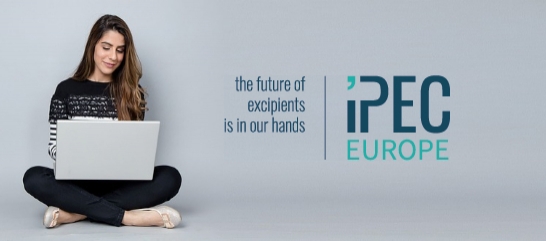
Members reunited on Friday 7 February at the Renaissance Hotel Aix-en-Provence for the Annual General Meeting of IPEC Europe. The Board and the Committees’ representatives presented updates on current activities, achievements in 2019 and objectives for 2020.
Members approved the proposed change to the Articles of Association of IPEC Europe, aligning them with the new Belgian law for asbl’s. These changes do not affect the responsibilities of IPEC Europe Members.
IPEC Europe Chair Frithjof Holtz presented to members the “Agenda 2025 – The Way Forward”, defining the priorities and the goals of the association for the next five years. The Board of Directors identified six focus areas to reach the overarching goal of “being recognised as the Voice of Excipients in Europe”. These are:
- Communication
- Global Collaboration
- Regulations
- Knowledge Sharing
- Compendial Compliance
- Membership and Recruitment
Amina Faham (DuPont, Producers group) and Liz Meehan (AstraZeneca, Users group) were re-elected to their positions on the Board for a three-year term of office.
The profile of all Board members is available on the IPEC Europe website.
All presentations made by Board officials and Committee and Task Force leaders are available in the Member’s Lab: Members / Annual General Meeting / 2020 Annual General Meeting - 7 February - Aix-en-Provence, France .
IPEC Europe assumes the presidency of the IPEC Federation!
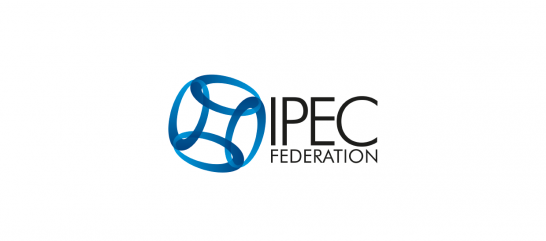
IPEC Europe took over the presidency of the IPEC Federation with Frank Milek, IPEC Europe vice Chair. Frank succeeded Priscilla Zawislak, IPEC-Americas, now vice-President of the Federation.
The IPEC Federation had a face-to-face meeting and the Annual General Assembly in Aix-en-Provence in early February. Attendees from Americas, Europe and Japan were present to discuss the results of the past year and the objectives of 2020.
2019 was a productive year for the Federation, with the publication of the Technical Report 54-6 on risk assessment with PDA and two position papers. The new website and the infographic were published, too.
For 2020, the IPEC Federation aims to publish the Data Integrity position paper and continue its revision process of guidelines such as the GMP Audit Guide, the Qualification Guide for Pharmaceutical Excipients and the GMP Audit Guide. The Federation will continue contributing to ICH as an observer member.
PDA – IPEC Federation Technical Report 54-6 on Formalized Risk Assessment for Excipients now available
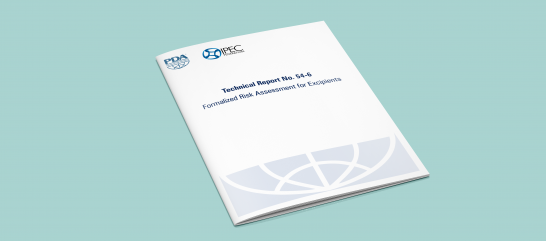
The joint PDA-IPEC Federation Technical Report 54-6: Formalized Risk Assessment for Excipients is now available. This technical report provides guidance on quality risk management (QRM) principles that can be used to assess the risks to the quality, safety, and function of an excipient in a drug product.
A webinar highlighting the guide content will be presented by IPEC Europe Chair Frithjof Holtz on Thursday 12 March from 16:00. For more information about the webinar, click here.
The technical report provides practical guidance to be used in conjunction with existing regulatory and industry standards, and extends the PDA Technical Report No. 54 series on Quality Risk Management.
PDA-IPEC Federation Technical Report No. 54-6 includes:
- Evaluations that can be used to provide an overall view of the risk question “Is the excipient fit for use?”
- A generic risk assessment model and a holistic strategy applicable to excipient use for all dosage forms
- Discussion of end-to-end supply chain risks and information gathering
- Control strategy, and benefits and challenges
The Technical Report No. 54-6 is a response to 2015 EC guidelines on risk assessments for excipients. In 2018, PIC/S incorporated the same provisions for formalized risk assessment into a publication of the same name, extending the provisions to have global applicability. The technical report is grounded in the general principles outlined in ICH Quality Guideline Q9 Quality Risk Management.
As an IPEC Europe member, you can access and download the Technical Report free of charge in the Member’s Lab under Members / Useful Documents and Guidelines.
If you do not have access to the Member’s Lab, please contact the Secretariat.
Webinar: The PDA/IPEC Federation Technical Report on excipient risk assessment
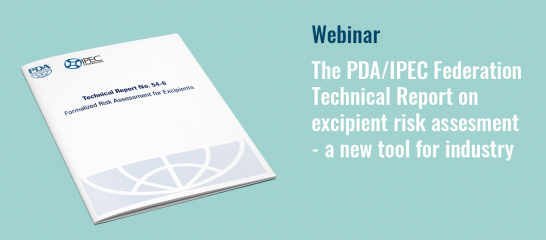
Since March 2016 the EC Guidelines (2015/C 95/02) to ascertain the appropriate GMPs for excipients of medicinal products for human use are legally binding. Although the EC Guidelines itself provides a high level description how to perform the risk assessment, the implementation can be challenging.
On 17 December 2019, PDA and IPEC published a joint Technical Report to provide state of the art approaches and practical examples how to perform a risk assessment in line with the EU requirements.
The Technical Report is available free of charge exclusively for IPEC Members.
The Technical Report is available on the PDA website for purchase for IPEC Non Members: go.pda.org/tr54-6
DATE AND TIME
Thursday 12 March 2020 - 16:00-17:00 CET
PRESENTER
Frithjof Holtz, Senior Expert Regulatory Intelligence Life Science, Regulatory Management, Merck KGaA / IPEC Europe Chair
Frithjof Holtz is a biologist working for nearly 30 years for Merck KGaA, Darmstadt, Germany. He has experience in operations, QA and has over the last 15 years several positions in Regulatory Management (CMC) in Merck Life Science. Over the last years he has been working with a number of industry associations (e.g. Rx-360, APIC, EFCG, PDA, IPEC) and is as Senior Expert responsible for Regulatory Intelligence for Merck LS.
REGISTRATION FEES
IPEC Members: € 60
IPEC Non Members: € 80
If you are unsure of your status, please contact the Secretariat at info@ipec-europe.org
CANCELLATION POLICY
The registration fee for the webinar is not reimbursable. Substitutions are accepted. Webinar participants who are unable to attend should inform the IPEC Europe Secretariat (info@ipec-europe.org) in writing and provide the name of the replacement, if applicable, no later than Monday 9 March 2020 eob.
Pharmeuropa 32.1 – Nitrosamines and elemental impurities
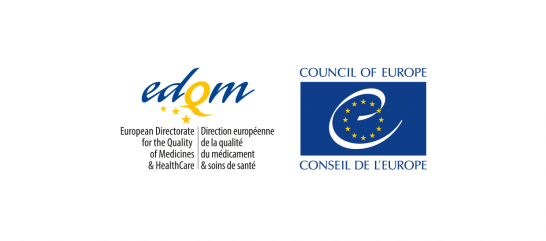
Nitrosamines
The Ph. Eur. Commission has proposed to revise the general monograph on Substances for pharmaceutical use (2034), including a requirement to perform a risk assessment of the manufacturing process and implement a control strategy for the detection and control of N-nitrosamine impurities in the Production section.
This would apply to excipients, even those without a specific monograph.
In the absence of response, the proposed revision will be considered as acceptable, hence IPEC Europe has re-convened its Task Force on Nitrosamines to address this revision before the deadline of 31 March 2020.
EDQM
Elemental impurities
The European Directorate for Quality of Medicines (EDQM) published in Pharmeuropa 32.1 eleven draft monographs regarding excipients in January 2020 with proposals to include specific elemental impurity and limit requirements.
In its press release of January 2017, the Ph. Eur. Commission decided to keep the published specific elemental impurities tests in monographs on substances of natural origin only.
While IPEC Europe reviews its position on EDQM’s approach, suppliers and users of these substances are strongly encouraged to provide their comments, including supporting data, before 31 March 2020. A “How to comment” guide is available on the EDQM website.
External Events: EFCG Annual Meeting, World Pharmacopoeias Symposium, Making Pharmaceuticals
EFCG Annual Meeting
IPEC Europe Managing Director Carole Capitaine attended the Annual Meeting of the European Fine Chemicals Group (EFCG), a sector group of CEFIC, on Thursday 30 January, to present the preliminary results of the joint survey on a European Master File system for novel excipients.
“Meet the World Pharmacopoeias” Symposium
IPEC Europe attended the EDQM World Pharmacopoeia Symposium on 20 February. T The one-day Symposium co-hosted by the EDQM in Strasbourg on 20 February was a great opportunity to talk about the future of harmonisation and pharmacopoeial convergence worldwide.
Representatives of the WHO, of national and regional pharmacopoeias and from the industry presented and exchanged views on how co-operation is important and the possible way to achieve harmonisation. All emphasised the need of a bottom up approach and to encourage convergence and functional equivalence.
Janeen Skutnik-Wilkinson presented the IPEC’s perspective on pharmacopoeial evolution. Harmonisation has proven to be difficult for different reason including politics.
Janeen emphasised that from a patient safety point of view there are no risk to use a medicine tested only against on the pharmacopoeia. So, what is the benefit for the patient to have multiple standards and testing? The excipient industry encourages functional equivalence that would allow recognition of standards.
All stakeholders agreed on the importance to continues the collaboration between pharmacopoeias worldwide but also to strengthen the collaboration with the industry.
Making Pharmaceuticals in Coventry, UK
On 28 and 29 April 2020, meet us at Making Pharmaceuticals to discover more about IPEC Europe!
Making Pharmaceuticals will host over 2,000 visiting pharma professionals over two days, and 200+ exhibitors from across Europe.
As in previous year, IPEC Europe will be represented at Stand 108. Our staff will be pleased to present to you the activities of the association and the benefits of being a member of IPEC Europe.
The full conference programme and registration to this free-to-attend event is available at this link: Making Pharmaceuticals UK – Coventry.
Mark your calendar for the sessions hosted by IPEC Europe:
|
Wednesday 29 April - Room A
|
|
9:15
|
IPEC Co-Processed Excipient Guide for Pharmaceutical Excipients
Dr Liz Meehan, AstraZeneca / IPEC Europe Board member
|
|
9:35
|
The Role of Excipients in Paediatric Formulations
Kevin Hughes, Colorcon / IPEC Europe Board member
|
|
9:55
|
Excipients for Parenteral Formulations
Dr Iain Moore, CRODA / EXCiPACT President
|
EXCiPACT: new brochure and events
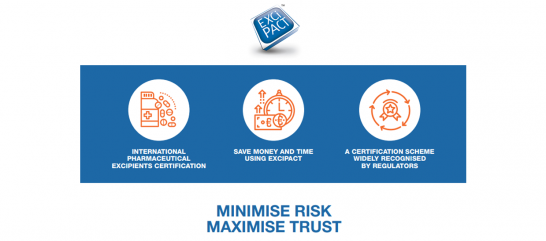
2019 was another successful year for EXCiPACT as the association experienced further growth in new certifications, reaching 104 certificates overall by the end of 2019, with a high retention of existing certified plants. A new promotional brochure was launched at the 2020 IPEC Europe Forum in Aix-en-Provence in February and is available on the EXCiPACT website.
EXCiPACT is providing regular 2-day auditor training courses, 1-day general awareness courses and half-day, free-to-attend educational seminars.
Upcoming courses and seminars are:
26 March – Free-to-attend Seminar – Frankfurt, Germany
22-23 April – Two-day EXCiPACT Auditor Training Course - Brussels, Belgium
EXCiPACT will be present at Making Pharmaceuticals in Coventry, UK - do not forget to pay a visit at stand 108.
What is IPEC Europe doing for novel excipients?
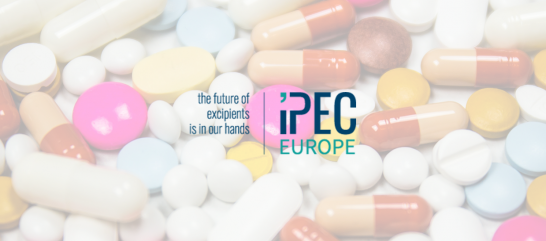
Novel excipients play a pivotal role in the development of advanced drug delivery systems and enhance the quality and the safety of medicines for patients. There are significant challenges in their development, not least because of the absence of aligned regulatory mechanisms for their approval.
Currently, a novel excipient can only be introduced in Europe as part of the drug product marketing authorisation meaning that details on excipient quality, manufacturing and safety are shared with the drug product applicant.
In other regions, drug developers can rely on systems that allow an excipient manufacturer to submit the necessary details on their product to regulatory authorities without disclosing proprietary manufacturing information to third parties.
IPEC Europe is actively monitoring novel excipients actions in Europe and in other regions.
If you are aware of any initiatives on this topic, please contact the Secretariat.
Europe: first results of the EMF joint survey available
IPEC Europe and EFCG published a joint survey to collect information to advocate for the introduction of an EMF system in Europe for novel excipients.
The survey collected more than 60 complete responses and we thank all respondents for taking the time to provide useful information to help us build the case with other stakeholders.
The survey is available here : https://surveyhero.com/c/EMFsurvey
U.S.: input provided to support FDA’s Plans to Review Novel Excipients Outside of Applications
The Food and Drug Administration (FDA) solicited input from stakeholders through the public “Novel Excipient Review Program Proposal; Request for Information and Comments” docket.
IPEC Europe provided input and supports this pilot review programme, and believes that such an initiative can reduce the concerns of drug developers to use novel excipients or use approved excipients in a novel way (e.g. higher use levels, or different route of administration than previously approved).
Comments submitted to the FDA are available here.
Regulatory News: Europe
European Union
Classification of titanium dioxide in Classification Labelling Packaging (CLP) Regulation published in EU Official Journal
The European Union published on 18 February a delegated regulation classifying titanium dioxide (TiO2) as a category 2 suspected carcinogen by inhalation under EU Regulation (EC) No 1272/2008 on classification, labelling and packaging of substances and mixtures (CLP Regulation).
Only mixtures in powder form containing 1% or more of titanium dioxide with aerodynamic diameter of 10 micrometre or less will be required to carry cancer warnings on the label, informs Chemical Watch.
In light of this change TiO2 would be banned from use in cosmetics under the Cosmetic Products regulation; based on a request submitted by an industry association, the European Commission instructed the Scientific Committee on Consumer Safety (SCCS) to provide an opinion on the safety of titanium dioxide as a colourant and as an ingredient in all other cosmetic products. The SCCS has six months to prepare its opinion.
Annex 1: second targeted Stakeholders' Consultation on manufacturing of sterile medicinal products
On 20 February, DG SANTE published a further draft of the revision of Annex 1 of the EU GMP Guide to Good Manufacturing Practice. This document enters a 3-month phase of commenting by concerned organisations and stakeholders: comments can be sent until 20 May 2020.
Download the draft guideline here – If you wish to provide comments, send an e-mail to SANTE-REVISION-OF-ANNEX-1@ec.europa.eu to receive the dedicated template for the response.
European Commission / GMP Compliance
COVID-19 (Coronavirus): the EU’s response
The European Union published a webpage with all the key updates on the outbreak of the COVID-19, available at the URL https://ec.europa.eu/health/coronavirus_en .
The European Centre for Disease Prevention and Control, the European Medicines Agency and the World Health Organization include further updates on the current outbreak of the disease.
The EMA announced that it “activated its plan for managing emerging health threats” and encourages developers of potential treatments to contact the agency as soon as possible.
European Medicines Agency (EMA)
Information on nitrosamines for marketing authorisation holders - Questions and answers
The European Medicines Agency and the CMDh updated the questions-and-answers document for marketing authorisation holders who are currently reviewing their medicines for the possible presence of nitrosamines and testing products at risk. The updated document clarifies how biological products containing excipients potentially at risk of contamination with nitrosamines are not in the scope of the review until further notice (see question 14).
European Medicines Agency
Information on Brexit
During the transition period, pharmaceutical companies can continue to carry out activities in the UK as before.
EMA informs that “companies have until 31 December 2020 to make the necessary changes to ensure that their authorised medicines comply with EU law and can remain on the EU market”.
The EMA will publish updated guidelines on Brexit shortly.
European Medicines Agency
European Authorities working to avoid shortages of medicines due to Brexit – questions and answers
The United Kingdom formally left the European Union on 31 January 2020. On 1 February 2020, a transition period started which is due to end on 31 December 2020. The relationship between the UK and the EU after this date is currently unknown – this Q&A provides answers to potential questions on the supply of medicines in the EU after Brexit enters into force.
European Medicines Agency
Comments open for EMA Reflection paper on GMP and Marketing Authorisation Holders
The European Medicines Agency has released a new draft reflection paper on Good Manufacturing Practice and Marketing Authorisation Holders. The aim of the reflection paper is to clarify in a single document what the different responsibilities are and what they mean for MAHs at a practical level. It also addresses the legal provisions in European Directives and other Directives that relate to GMP and also affect marketing authorisation holders.
Comments should be provided using this template and submitted to adm-gmdp@ema.europa.eu on or before 17 April 2020.
RAPS / ECA Academy
European Directorate for Quality of Medicines (EDQM)
New website on nitrosamine contamination
The European Directorate for the Quality of Medicines and Healthcare (EDQM) launched a new web page with all information related to nitrosamine impurities.
GMP Compliance / EDQM
World Pharmacopoeias move towards increased global cooperation
EDQM and WHO hosted the 11th International Meeting of the World Pharmacopoeias in Strasbourg, France on Thursday 19 February. Among the topics discussed, a new framework for exchanging information between PDG and IMWP, updates on nitrosamine contaminations.
EDQM
European Pharmacopoeia welcomes its 39th member state, Albania
On 9 February 2020, the Convention on the Elaboration of a European Pharmacopoeia entered into force in Albania, making the quality standards for medicines published in the European Pharmacopoeia (Ph. Eur.) legally binding throughout the country.
EDQM
Regulatory News: rest of world
U.S. Food and Drug Administration (FDA)
FDA’s Actions in Response to 2019 Novel Coronavirus at Home and Abroad
The U.S. agency announced that all inspections of facilities in China are suspended until further notice. The Agency is reaching out to drug manufacturers to identify potential disruptions and shortages across the supply chain.
FDA
U.S. Pharmacopoeia (USP)
Novel Excipients: New Hope for Therapeutic Innovations
Catherine Sheehan highlights the results of a novel excipients survey in 2019 (findings of this survey are available in this USP document presented in the Excipients Stakeholder Forum in November).
US Pharmacopoeia
The Future is Digital: Our last printed USP–NF
USP announces that the USP-NF printed version is discontinued on 1 February 2020 in favour of the online website www.uspnf.com that will be the only source for all current USP–NF content.
The First Supplement to USP43–NF38, published on February 1, 2020, is only available online.
ECA Academy
International Council for Harmonisation (ICH)
ICH Assembly Meeting : plans to cooperate with PIC/S and WHO
The minutes of the latest ICH Assembly Meeting in Singapore in November 2019 include interesting details on cooperation plans between the International Council for Harmonisation, and PIC/S and the World Health Organisation. The next ICH meeting will be in May 2020 in Vancouver, Canada.
ICH (Minutes of Singapore meeting) / GMP Publishing
Calendar
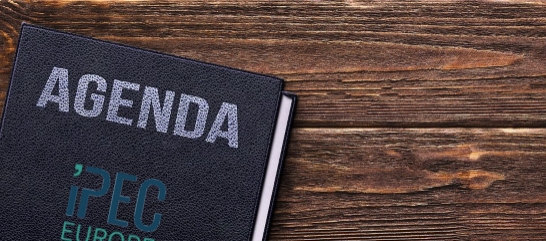
| Group |
2020 |
| IPEC Europe Board |
19 March, Darmstadt, Germany
24 June, Brussels, Belgium
23 September, Brussels, Belgium
25 November, Brussels, Belgium |
| Good Distribution Practices Committee |
28-29 April, Brussels, Belgium
30 June - 1 July
29-30 September
1-2 December |
| Quality & Regulatory Affairs Committee |
23 April, Brussels, Belgium
2 July, Brussels, Belgium
27 October, Brussels, Belgium |
| Multicompendial Compliance TF |
March, TC |
| Lactose Interest Group TF |
18 March, TC
26 May, TC
22 September, TC |
Recommended readings

Managing Excipient Interactions
The key is to ensure that excipients only interact with APIs via desired mechanisms – how to idenfity the right excipients for each formulation?
Pharmaceutical Technology
The Search for Transparency in Excipient Sourcing
Researching excipient grades and sources, as well as screening suppliers and materials, form the basis of programs to mitigate risk.
Pharmaceutical Technology
The Excipient of the Future
Advances in manufacturing aren’t enough to overcome the challenge of poorly soluble APIs – we must also embrace novel approaches to excipients, suggests Dieter Lubda, Merck KGaA.
The Medicine Maker
A guide to pharma EU risk assessment
Frithjof Holtz, Advocacy & Surveillance Life Science Regulatory Management at Merck KGaA and IPEC Europe Chair, offers a practical view on the implementation of the EU Excipient Risk Assessment Guidelines. Voluntary industry standards and the IPEC Guides are a good starting point for Marketing Authorisation Holders.
European Pharmaceutical Manufacturer
A Circular Debate - Are continuous manufacturing technologies proving their worth in practice?
Given the oft-discussed advantages of continuous manufacturing, why does batch manufacturing still dominate the market? A conference on Continuous Manufacturing in September 2019 discussed how research groups could accelerate its adoption for small molecules and biologic products. According to Moheb Nasr, Principal at Nasr Pharma Consulting, pharmacopoeias need to play a more active role in defining the requirements of continuous manufacturing. The IPEC co-processed excipient guide was mentioned as a positive factor to accelerate the acceptance of excipient monographs for co-processed, high-functionality excipients.
The Medicine Maker
An Analysis of MHRA’s Annual GMP Inspection Deficiencies Report
An analysis of warning letters issued by the Medicines and Healthcare products Regulatory Agency (MHRA) for Good Manufacturing Practice (GMP) violations in fiscal 2018 has revealed that Quality Systems continues to be the main cause of inspection deficiencies.
Pharmaceutical Online
U.S. Sites Play Surprise Starring Role In FDA's Drug GMP Warning Letter Report
Warning letters issued to firms in the U.S. far exceed the number issued to firms outside the U.S. for the first time in the last eight years, highlights Barbara Unger, Unger Consulting Inc.
Pharmaceutical Online
Is there anything like European Warning Letters?
Non compliance reports included in the EudraGMDP database are final decisions about a GMP non-compliance, while FDA-based Warning Letters allow companies to react.
ECA Academy / EudraGMDP
Events

Here is a round-up of forthcoming events of interest to suppliers and users of excipients. Please let the IPEC Europe Secretariat know if we've missed one.
11th Global Drug Delivery & Formulation Summit
Berlin, Germany – 9-11 March 2020
More information here
Nitrosamine Impurities
Frankfurt, Germany – 19 March 2020
More information here
12th World Meeting on Pharmaceutics, Biopharmaceutics and Pharmaceutical Technology
Vienna, Austria – 23-26 March 2020
More information here
2020 ISPE Europe Annual Conference
Madrid, Spain – 30 March – 1 April 2020
More information here
2020 PDA Annual Meeting
Raleigh, NC., U.S. – 30 March – 1 April 2020
More information here
Making Pharmaceuticals UK
Coventry, United Kingdom – 28-29 April 2020
More information here
EU Health Summit
Brussels, Belgium – 4-5 May 2020
More information here
Excipient World 2020 Conference & Expo
Kissimmee, FL., U.S. – 11-13 May 2020
More information here
ChemSpec Europe
Cologne, Germany – 27-28 May 2020
More information here
IPEC Europe Excipient Conference
Frankfurt, Germany – 16-17 September 2020
More information here ¦ Registration opening soon!
Making Pharmaceuticals Ireland
Dublin, Ireland – 29-30 September 2020
More information here
POWTECH 2020
Nürnberg, Germany – 29 September – 1 October 2020
More information here
CPhI Worldwide 2019
Milan, Italy – 13-15 October 2020
More information here
|